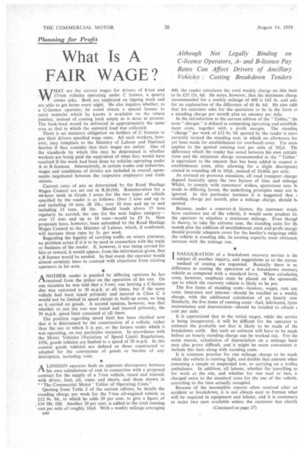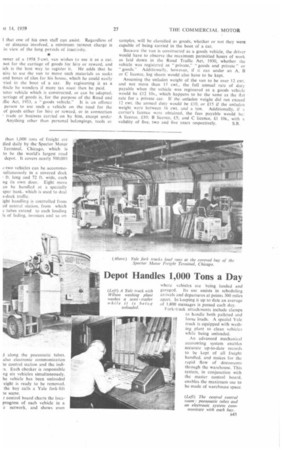What Is A FAIR WAGE?
Page 74

Page 77

If you've noticed an error in this article please click here to report it so we can fix it.
Although Not Legally Binding on C-licence Operators, Aand B-licence Pay Rates Can Affect Drivers of Ancillary Vehicles : Costing Breakdown Tenders
WHAT are thc correct wages for drivers of 8-ton and 15-ton vehicles operating under C licence, a quarry owner asks. Both are employed on tipping work and are able to get home every night. He also inquires whether, as a C-licence operator, he could obtain a special licence to carry material which he knows is available on the return journey, instead of coming back empty as is done at present. The back-load would be delivered in approximately the same area as that in which the outward load was collected.
There is no statutory obligation on holders of C licences to pay their drivers specified wage rates. All such workers, however, may complain to the Ministry of Labour and National Service if they consider that their wages are unfair. One of the standards by which this may be determined is whether workers are being paid the equivalent of what they would have received if the work had been done by vehicles operating under A or B licences. Alternatively, in certain trades and industries, wages and conditions of drivers are included in overall agreements negotiated between the respective employers and trade unions.
Current rates of pay as determined by the Road Haulage Wages Council are set out in R.H.(64). Remuneration for a 44-hour week in Grade I areas for the two types of vehicle specified by the reader is as follows: Over 5 tons and up to and including 10 tons, £8 10s.; over 10 tons and up to and including 15 tons, £.8 16s. Should loads above 15 tons regularly be carried, -the rate for the next higher category— over 15 tons and up to 18 tons—would be £9 3s. New proposals have, however, been submitted by the Road Haulage Wages Council to the Minister of Labour, which, if confirmed, will increase these rates by 5s. per week.
Regarding the legality of carrying traffic on return journeys, no problem arises if it is to be used in connection with the trade or business of the reader. If, however, it was being carried for hire or reward, it would appear, from the information given, that a B licence would be needed. In that event, the operator would almost certainly have to contend with objections from existing operators in his area.
ANOTHER reader is puzzled by differing opinions he has received from the police on the operation of his van. On one occasion he was told that a 5-cwt. van bearing a C-licence disc was restricted to 30 m.p.h. at all times, but if the same vehicle had been taxed privately and insured in Class C it would not be limited in speed except in built-up areas, so long as it carried no goods. A second opinion, however, was that whether or not the van was taxed and insured privately, the 30 m.p.h. speed limit remained at all times.
The position regarding speed limit has been clarified now that it is determined by the construction of a vehicle, rather than the use to which it is put, or the licence under which it was operating, on any particular occasion. In accordance with the Motor Vehicles (Variation of Speed Limit) Regulations, 1956, goods vehicles are limited to a speed of 30 m.p.h. In this context goods vehicles are defined as those constructed or adapted for the conveyance of goods or burden of any description, including vans.
A LONDON operator finds an apparent discrepancy between IA. his own calculations of cost in connection with a proposed contract for the supply of a 7-ton vehicle, taxed and insured, with driver, fuel, oil, ropes and sheets, and those shown in " 'The Commercial Motor' Tables of Operating Costs." Quoting from Table 2 of the current edition, he details the standing charge per week for the 7-ton oil-engined vehicle as £12 9s. 9c1., to which he adds 20 per cent. to give a figure of .£14 18s. 10d. Another 20 per cent. is added to the total running cost per mile of roughly 10-0. With a weekly mileage averaging a40
400, the reader calculates the total weekly charge on this basi! to be £35 15s. 6d. He notes, however, that the minimum charge recommended for a weekly mileage of 400 is £42 4s. and ask! for an explanation of the difference of £6 8s. 6d. He also add! that his customer asks for the quotation to be in the form a a standing charge per month plus an amount per mile.
In the introduction to the current edition of the "Tables," tht term " charges "! is defined as comprising operating and establish ment costs, together with a profit margin. The standiru "charge" per week of £12 9s. 9d. quoted by the reader is mon correctly termed the standing cost, in which no allowance ha! yet been made for establishment (or overhead) costs. The same applies to the quoted running cost per mile of 101d. The difference which the reader has noted between his own calcula lions and the minimum charge recommended in the " Tables ' is equivalent to the amount that has been added in respect a establishment costs, after allowing for a slight discrepanc3 caused in rounding off to 10-1-cl., instead of 10.60d. per mile. As stressed on previous occasions, all road transport charge depend basically upon the two factors of time and mileage Whilst, to comply with customers' wishes, quotations may IN made in differing forms, the underlying principles must not la, ignored. In this particular instance it is suggested that standing charge per month, plus a mileage charge, should bt quoted.
Because, under a contract-A licence, the customer wash have exclusive use of the vehicle, it would seem prudent fo the operator to stipulate a minimum mileage. Even thougl in theory, to take the extreme case, the standing costs for ON month plus the addition of establishment costs and profit margit should provide adequate cover for the haulier's outgoings while the vehicle is standing idle, its earning capacity must obvious]] increase with the mileage run.
T
NAUGU RATION of a breakdown recovery service is the 1 subject of another inquiry, and suggestions as to the correc
method of costing are requested. Basically there is n( difference in costing the operation of a breakdown recovery vehicle as compared with a standard lorry. When caleulatini costs, however, emphasis must be placed on the spasmodit use to which the recovery vehicle is likely to be put. The five items of standing costs—licences, wages, rent an( rates, insurance and interest—should be totalled as a weekly charge, with the additional calculation of an hourly rate Similarly, the five items of running costs—fuel, lubricants, tyres maintenance and depreciation—should be totalled to obtain cost per mile.
It is appreciated that in the initial stages, while the servic( is being inaugurated, it will be difficult for the operator tc estimate the probable use that is likely to be made of tit( breakdown outfit. But such an estimate will have to be mad( before an hourly standing charge can be worked out. For tin same reason, calculation of depreciation on a mileage basie may also prove difficult, and it might be more convenient tc include this item along with standing costs.
It is common practice for one mileage charge to be math while the vehicle is running light, and double that amount wher executing a simple or suspended tow, or carrying on a trolley ambulance. In addition, all labour, whether for travelling oi for work at the site, and whether for one man or two, charged extra to the standard rates for the use of the vehicle, according to the time actually occupied.
Because of the incomplete reports often received after an accident or breakdown, it is not always easy to foresee what will be required in equipment and labour, and it is customary to make two men available unless the customer has clearly 1 that one of his own staff can assist. Regardless of or distance involved, a minimum turnout charge is in view of the long periods of inactivity.
)wner of a 1958 5-cwt. van wishes to use it as a car, not for the carriage of goods for hire or reward, and ich is the best way to register it. He adds that he uire to use the van to move such materials as sacks and boxes of tiles for his house, which he could easily Tied in the boot of a car. By registering it as a !hide he wonders if more tax must then be paid.
totor vehicle which is constructed, or can be adapted. :arriage of goods is, for the purpose of the Road and .ffic Act, 1933, a "goods vehicle." It is an offence person to use such a vehicle on the road for the of goods either for hire or reward, or in connection trade or business carried on by him, except under Anything other than personal belongings, tools or samples, will be classified as goods, whether or not they were capable of being carried in the boot of a car.
Because the van is constructed as a goods vehicle, the driver would have to observe the maximum permitted hours of work as laid down in the Road Traffic Act, 1930, whether the vehicle was registered as " private," " goods and private " or "goods." Additionally, however, if it ran under an A. B or C licence, log sheets would also haVe to be kept.
Assuming the unladen weight of the van to be over 12 cwt. and not more than 15 cwt., the full annual rate of duty payable when the vehicle was registered as a goods vehicle would be £12 10s., which happens to be the same as the ilat rate for a private car. If the -unladen weight did not exceed 12 cwt. the annual duty would be £10, or £15 if the unladen weight were between 16 cwt. and a ton. Additionally, if -L carrier's licence were obtained, the fees payable would be: A licence, £10; B licence, £5; and C licence, £1 10s., with a
validity of five, two and five years respectively. S.B.




















































































































